Recognizing Bed Bugs Bites marks one of the early signs of Bed Bugs Infestation,The impression of being unable to get rid of pests is unsettling for both homeowners and businesses, and recent studies indicate that early detection can achieve cost savings of as much as 40 percent in treatment expenses, as well as avoid the mental trauma of a severe infestation. This report explores the most definitive early signs of bed bugs and their characteristics and typical hiding places, drawing on the latest scientific understanding of bed bug behavior and detection techniques.
Visual Evidence and Early Signs of Bed Bug on Furniture
Furnitures, bedding and mattresses always have signs first before the bugs actually appear which is the clear sign of them infesting the house. Most bugs are not noticed before the household infests.
1- Bloodstains on Sheets and Bedding:
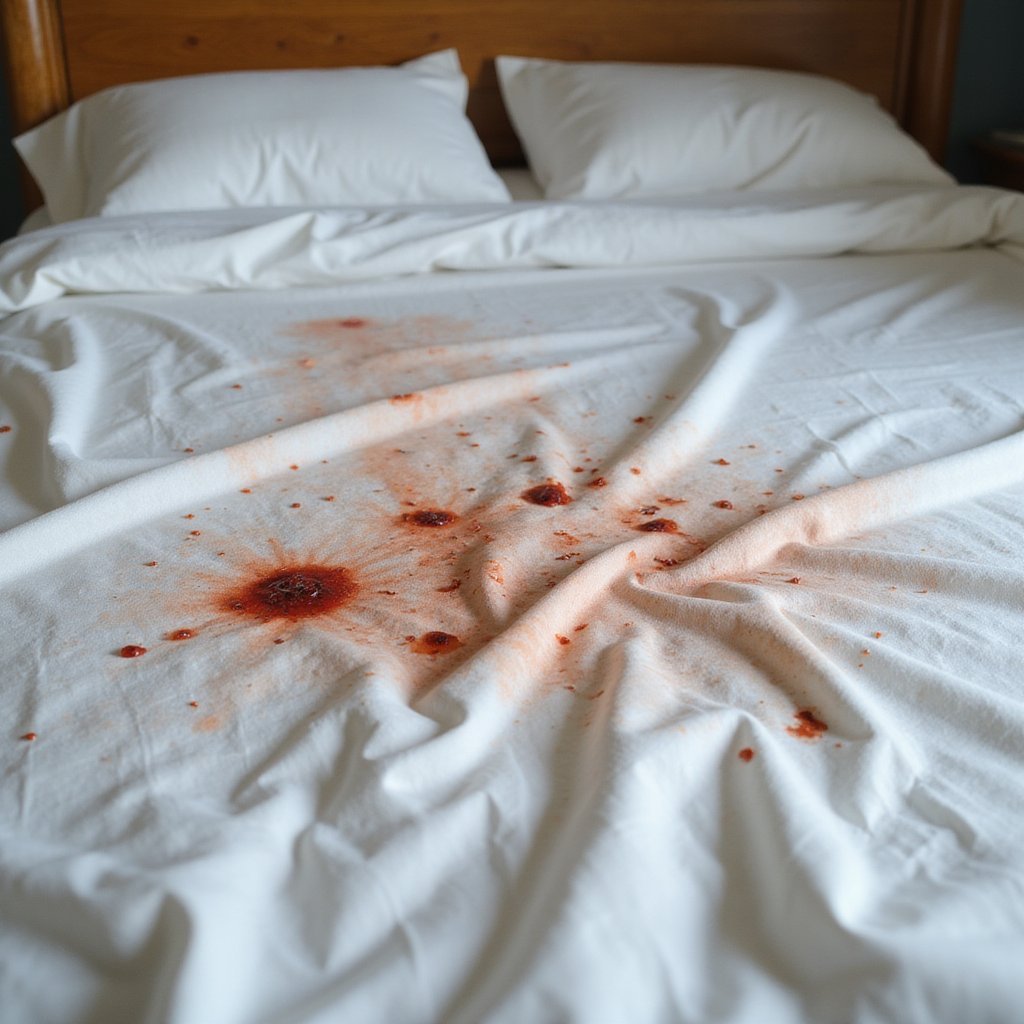
Bloodstains are one of the earliest and most recognizable signs of bed bug activity. These stains typically appear as small dots or smears on sheets, pillowcases, and mattresses. They occur when bed bugs are inadvertently crushed after feeding or when their feeding causes small wounds that continue to bleed slightly after the insect has finished feeding. These bloodstains are often rusty or reddish in color and may be more noticeable on light-colored bedding. Morning checks of bedding are particularly effective, as these stains are most visible after a night of bed bug feeding activity.
In contrast to other signs, bloodstains may be present even when there are very few bed bugs, so they are useful early signs prior to the establishment of an infestation. Bedding should be regularly inspected, particularly after unexplained discomfort or itching during sleep, to detect an infestation in its very early stages.
2- Fecal Marks and Staining
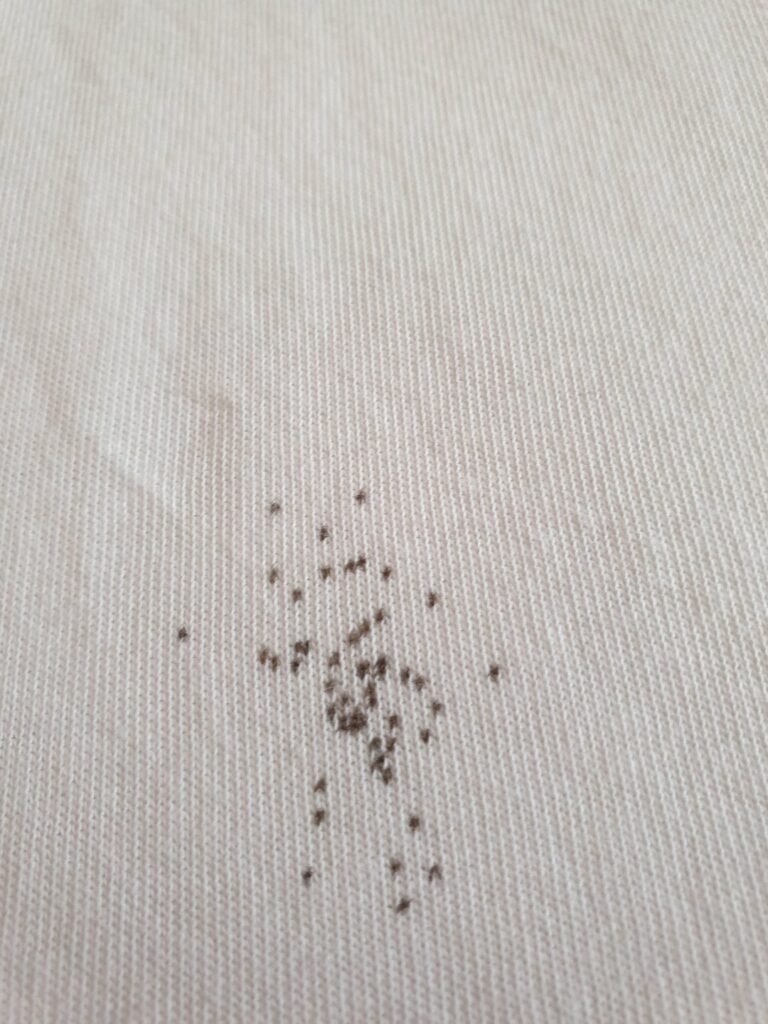
Bed bug feces form dark, rusty-brown to black spots on fabric or surfaces, which represent one of the most reliable signs of bed bugs. Fecal spots are digested blood, which is responsible for their coloration. Fresh feces will appear bright red initially, but will begin to darken as they dry and oxidize.
To give you an idea of their size, each individual dropping is roughly 1 mm in diameter, which is about the size of a mark made by a ballpoint pen tip. What is unique about these markings is that they are often clustered together, or lined up to follow the direction of the bed bug’s movement. This is especially evident when inspecting mattress seams, box springs, and headboards where bed bugs have scurried, leaving behind identifiable tracings of their movement. Additionally, bed bug droppings may be identified at the base of rooms along baseboards, in corners, surrounding electrical outlet covers, or even along carpet edges.
When examining possible fecal marks, a defining feature is that they dissolve or smear when very lightly moistened, indicating that they are biological, not just dirt or debris. This is due to their high blood content. In the early stages of an infestation, these marks may be limited and contexted approximately to main harborage sites.
3- Shell Casings and Shed Skins
During their growth, bed bugs molt, shedding their exoskeletons. The shells they leave behind are translucent casings that provide a visual indication of their presence. The shells are shaped like bed bugs, and are light in color and distinctively empty of the bugs, substance, and vitality of the insects.
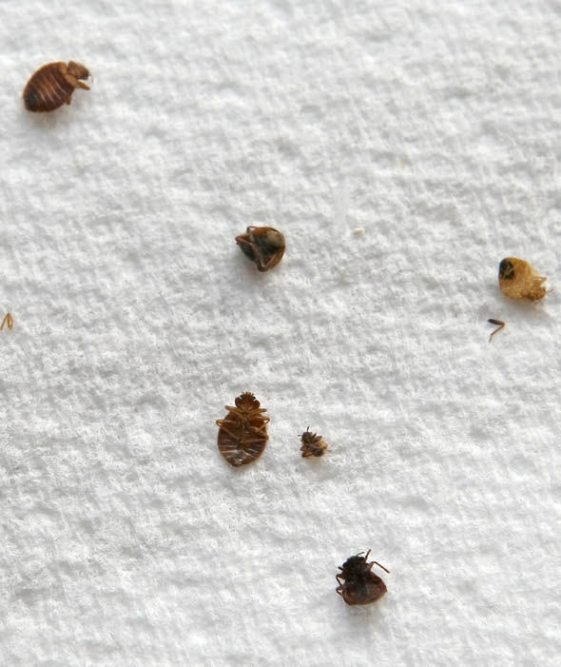
Cast skins collect quickly, especially in locations where bed bugs are found. At first during an outbreak, cast skins may be observed in distant locations, on or near seams of mattresses, edges of box springs or frames of beds. If you find any cast skins, even just a few, you will definitely want to check the surroundings as it is clear a number of bed bugs were present at some time.
It’s important to examine these casings carefully, as smaller bed bug nymphs sometimes hide inside the shed skins of larger nymphs. Additionally, confusion with cockroach nymph skins or dermestid beetle remains is possible for untrained observers. The key distinguishing feature is that bed bug casings are flatter and more oval-shaped compared to the more elongated and segmented appearance of cockroach molts.
4- Eggs and Egg Casings
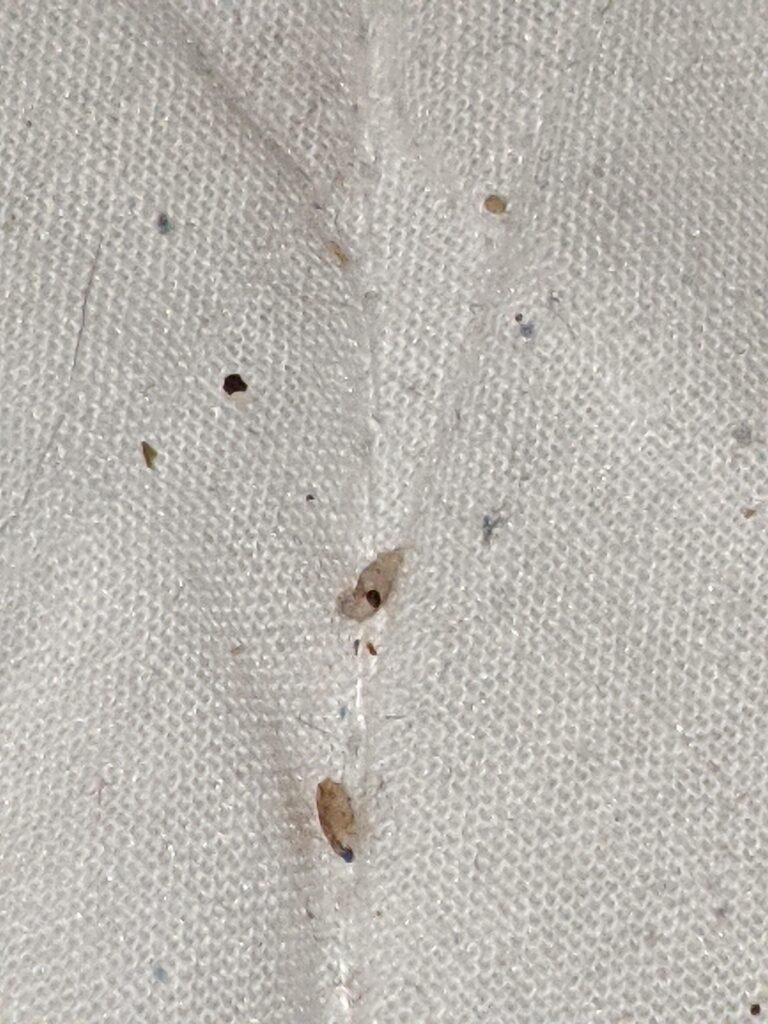
Bed bug eggs provide a early warning sign because they indicate there are not only bed bugs present but they are also reproducing, and likely in the process of building a bed bug population. The eggs are very small- around 1 mm in length, light in color (pearly white), and slightly curved, and they are frequently likened to small grains of rice.
Female bed bugs deposit 1-3 eggs per day, which develop and hatch within a 7-10 day period at room temperature. Eggs will revolve around a sticky substance that adheres the eggs to surfaces such as walls and furniture. Eggs are usually laid in clusters in primary harborage sites, but females will also wander and lay eggs as solitary eggs, sometimes considerable distances from the primary infestation. Therefore, a thorough inspection is essential.
Viable eggs are often observed to be plump and white in color. On the contrary, non-viable eggs may evidence as shriveled or collapsed. Often, as the eggs approach hatch time, they exhibit two red-eye spots near the cap end. Empty egg casings that are generally translucent with an opened cap end indicate that hatching has completed and nymphs are in the environment.
Physical Symptoms on the Human Body
Bed bug bites frequently serve as the initial sign that leads someone to look for additional signs that bed bugs may be present, but people’s reactions can be quite different.
Characteristic Bite Patterns
Bed bug bites generally appear to be small, red and itchy bumps on the skin that has been exposed. The bites usually occur on the face, neck, arms, hands or legs—by areas of the body that remain uncovered by clothing during sleep and are easy for the bugs to feed upon. Bites average in size from 2 to 5 mm across and can sometimes be quite itchy and/or swollen.
The pattern of bed bug bites sets them apart from bites by other insects. They often occur in patterns of three or four bites in either a line or zigzag configuration. This characteristic pattern is known as the “breakfast, lunch, and dinner” sign, as it reflects several feeding instances by the same bug moving along the skin. This pattern occurs because bed bugs are easily disturbed during feeding and may detach and reattach multiple times while feeding.
A further distinction is when your symptoms appear. For instance, bite reactions tend to be much more apparent in the morning upon waking, when bed bugs feed at night because of their nocturnal habits. Some bites may present with a small red dot or puncture mark in the middle – indicating the location of where the mouthparts of the bed bug penetrated the skin.
Skin Reaction Variations
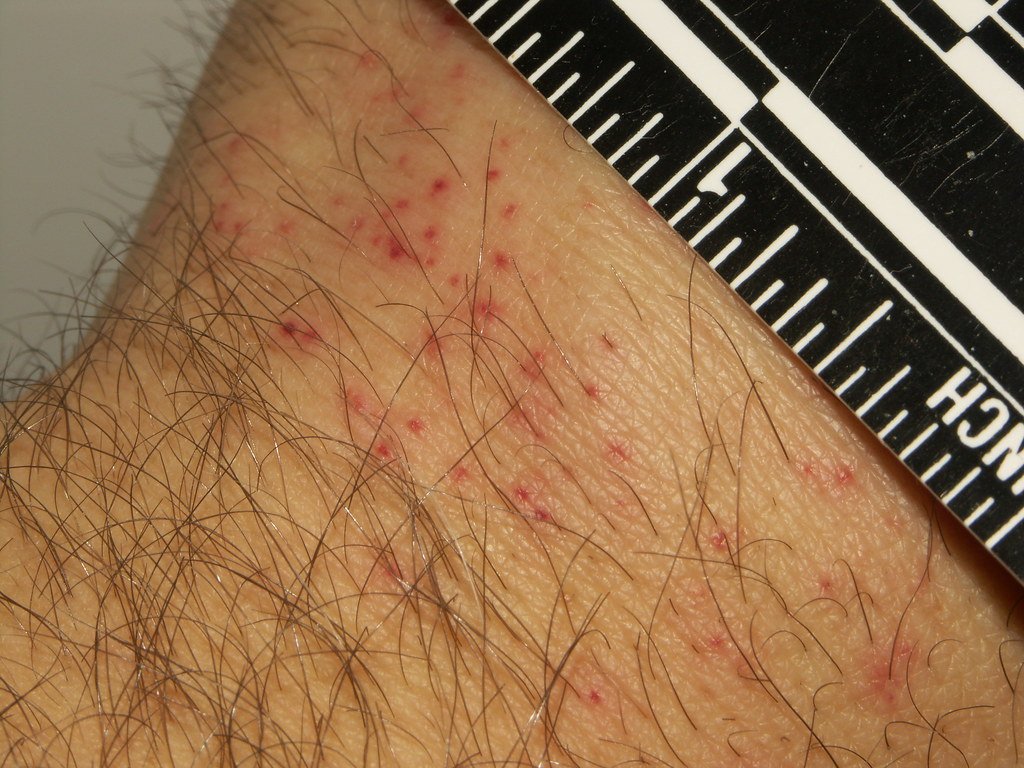
When evaluating possible bed bug bites, it is essential to bear in mind how different individuals can have extremely different responses to bites. About 30% of individuals display no visible response whatsoever to bed bug bites, making this sign of response, or not, unhelpful for individuals in this category. In individuals who become reactive to bites, responses can be anything from little redness to significant swelling or even severe itching.
Bed bug bites can occasionally form a small blister in the middle. In more serious reactions, there can be patchy inflammation, hives-like rash, or even a systemic allergic reaction in a highly sensitive person. Depending on exposure, the reactions usually increase in severity because the body gets sensitized to the components of the bed bug saliva.
Bite reactions can be easily confused with those caused by other insects such as mosquitoes, fleas, or spiders, as well as with skin conditions like hives, eczema, or fungal infections. This ambiguity underscores the importance of confirming suspected bed bug bites through the identification of other physical evidence of infestation.

Sensory Indicators of Bed Bugs
Aside from visible evidence, bed bugs may also be detected by some sensory cues, primarily their odor
Distinctive Odors
An indication that is often overlooked is their odor, which is usually more pronounced as the infestation grows. Bed bugs secrete pheromones, which have the sweet but musty aroma, often compared to the smell of berries, particularly raspberries, that one can smell sometimes when they’re present. The odor is also described as similar to cilantro or coriander, almonds, or marzipan, generally sweet but with a musty note.
The primary source of this smell is from bed bug pheromones, which the bugs use for communication and as a component of their aggregation behavior. This smell may be very mild and hard to detect early in an infestation, typically requiring someone to be near the harborage sites to notice the odor. As the population builds and the pheromones are produced in even greater concentration, the smell should become more intense.
As an infestation becomes more advanced, its odor becomes more pronounced, and “rusty” is the ensuing description.This is based on the decomposition of pheromones combined with the presence of dead bugs and fecal accumulation.When the bed bugs are disturbed, they will also emit “alarm pheromones,” which produce a completely different odor, often analogized to that of a crushed stink bug–woody, oily, and similar to the smell of burning rubber.
The presence of an unexplained sweet, musty odor, particularly concentrated around sleeping areas, should prompt a thorough inspection for other signs of bed bugs. This olfactory clue can be especially valuable in situations where visual signs are well-hidden or minimal.
Key Inspection Locations and Techniques
Knowing where and how to look for bed bugs significantly increases the chances of early detection.
Primary Hiding Locations
Bed bugs are proficient at hiding and typically prefer dark and narrow spaces that are close to their hosts. Some of the common hiding spots include seams, tufts, and folds of the mattress, all of which provide the creature (bed bugs) an opportunity to hide while still being close to food. Box springs are also popular hiding areas because there are so many spots to hide, including the fabric underside of the box spring and the wooden structure.
Bed frames and headboards offer alternative harborage areas, specifically in joints, cracks and through screw holes. Furniture that is made from metal or wood any of the available bed frames commonly has multiple tight areas where bed bugs can hide and remain protected during the day.While bed bugs will hide in the immediate sleeping area, it may also take up residence in nearby furniture that is similar to upholstered furniture such as a chair or couch or it could hide away in other furniture that allows for similar hiding possible conditions to the mattress.
As time goes on and infestations develop, bed bugs will add to their established territory by travelling to the baseboards, to the edges of carpets and to the hollows behind wall hangings. They will often take advantage of electrical outlets and switch plates, which give them direct access to the walls themselves. Bed bugs may also stay in curtains folds, cracks of bookshelves, and clothing piled next to the bed.
Most bed bugs stay within 8 feet of a sleeping area in the early stages of an infestation, which helps narrow inspection efforts to that area first. If an isolated bed bug is able to stay alive for several weeks without feeding, it may travel farther than 8 feet, especially to seek out new location for laying empty beds. Bed bugs can be found in places that are quite surprising – inside the screw slots of bed frames, in fabric seams, decals and behind peeling wall, and also under peeling paint.
Inspection Techniques and Tools
Proper inspection for bed bugs includes careful attention to detail and the appropriate tools. A flashlight with a bright beam is very important because bed bugs will move into shaded areas that are tough to inspect under normal lighting. Magnifying glasses can also assist in identifying smaller signs, such as eggs or smaller first-instar nymphs, which tend to be 1-2 mm in size.
While checking a mattress, first inspect the seams, piping, and tags, as these are most likely to serve as harborage sites. Gently lift the linen from the bed and examine the surface of the mattress for live bugs and their signs. The box springs need to be removed from the bed frame to be inspected, especially along the staple lines and corner guards on the underside.
When it comes to inspecting furniture for bed bugs, it can be helpful to use thin implements – think credit cards or paint scrapers to investigate any cracks and crevices. Use bed bug interceptors – these specialized devices can be placed underneath the legs of a piece of furniture, so you will not only be able to monitor whether bugs are attempting to travel from the floor to the feeding areas you are checking – you will also be able to continue ongoing monitoring., if the interceptors are deep enough.
In circumstances where a visual inspection leads to inconclusive results, specially certified bed bug detection dogs can be utilized. These dogs have the ability to detect the odor of live bed bugs and viable eggs with high degrees of accuracy, including inspections in locations that are inaccessible to human inspectors.
Early vs. Advanced Infestations
Understanding the progression of bed bug infestations helps in recognizing their earliest manifestations.
Distinguishing Early Warning Signs
An infestation of bed bugs will show early-stage evidence that is often modest yet identifiable. In the beginning, the evidence may include a few bites on one household member, as well as a few fecal spots clustered in a particular location, frequently the main sleeping area. It is during this phase that sightings of actual bugs is infrequent, though diligence in inspection may yield a couple of live bugs, which frequently consist of adults, considering a bed bug infestation originates with one or a few adults.
At this point, there will be few bloodstains and they will be isolated spots, small, rust-colored spots on bedding rather than extensive staining. There will be limited shed skins, and the skins will be located primarily next to the first harborage sites, usually within the structure of the mattress or box spring. The characteristic bed bug scent will typically not be present or only detectable at very close distance in new infestations.
Early detection of infestations typically offers many advantages regarding treatment effectiveness, costs, and the overall prevention of widespread infestation. At this stage, the population is still under numbers and distribution, allowing for more targeted treatment approaches to be effective and efficient. Further, the psychological impact on the affected residents is much less when dealing with infestations before they become established.
Indicators of Established Colonies
As infestations progress from early to established stages, there are more signs that are more numerous and spread out. Multiple members of the household typically report bites, and the classic ‘breakfast, lunch, dinner’ pattern is more easily noted. Live bed bugs are more prevalent including nymphs of a variety of ages, including adults, which indicates successful reproduction.
Fecal staining spreads to multiple locations, often radiating out from the area of original infestation. The blood spots seen on bedding will increase in amount and size, as a growing bed bug population engages in increased feeding activity and possible slaughter. Shed exoskeletons will accumulate in harborage sites, consisting of a variety of life stages – from somewhat diminutive first-instar shed skins to their larger adult remnants.
The distinctive sweet, musty smell becomes much more prominent and can be detected at some distance from harborage sites. In the more advanced stages of infestation, this odor is often stronger due to the accumulation of feces and dead bugs. Egg casings are generally present in large quantities in various locations, even far away from the primary sleeping sites, indicating further territorial expansion of the population.
Conclusion
The very best chances of minimizing the severity of bed bug infestations is to catch them early so that they have not established themselves yet. The most prominent early signs of bed bug presence can be seen in the bite patterns (for example, be on the lookout for a “breakfast, lunch, dinner” lines or zig-zag pattern), to small blood stains on bedding, dark fecal markings along the seams of the mattress, or bed frame, or other parts throughout the room, and possibly even shed skins or egg casings found nearby or in areas of primary sleep.
Periodic inspection of sleeping areas (especially mattress seams, box springs, bed frames, and adjacent furniture) is the most effective prevention strategy. Areas with cracks, crevices, and seams within eight feet of the sleep area would be particularly concerning. If you observe the emergence of a sweet, musty odor or experience an unexplained disturbance to sleep habits, then a more thorough investigation is warranted.
If you notice early signs of bed bugs, it is advised that you seek a professional assessment as soon as possible. While a do-it-yourself identification of a pest issue is helpful for initial detection, having an experienced professional properly identify the pest and develop a treatment plan increases the chance for total eradication dramatically. Early treatment is less complicated and less costly compared to treating an established infestation of pests and has less of a psychological effect on the occupants of the home.
